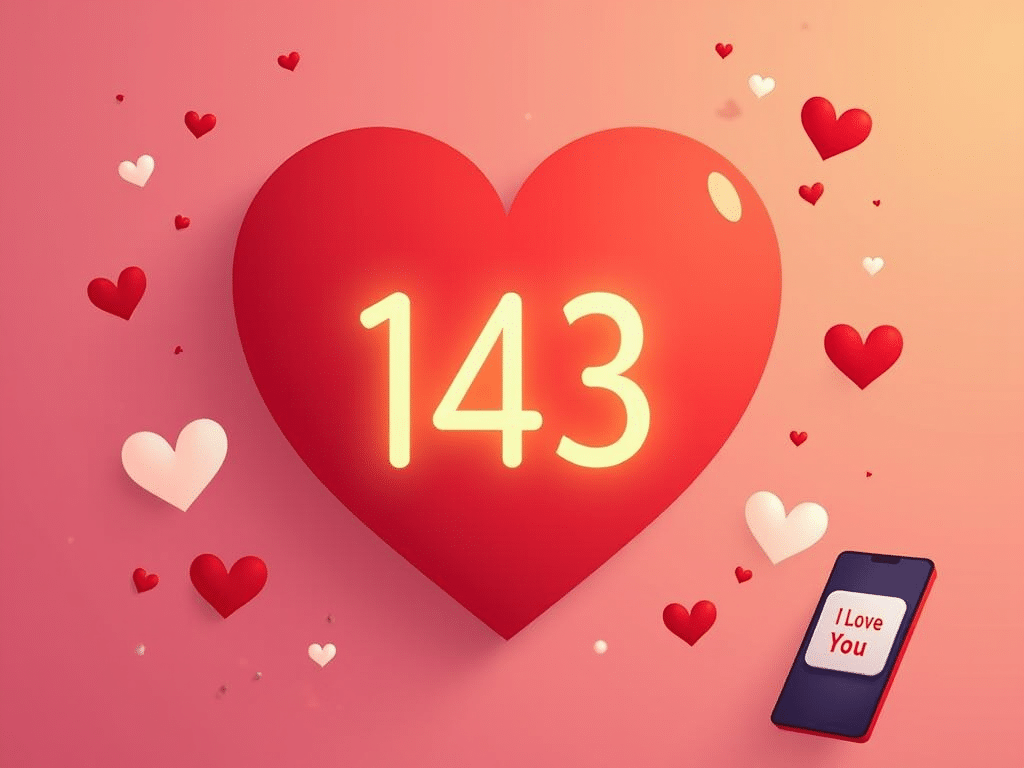Ever gotten a text that just says “143” and felt totally lost? Don’t worry, you’re not alone! This little number combo has been making waves in the world of texting and social media, and it’s time we cracked the code. The 143 meaning is actually super sweet, and once you know it, you’ll probably want to use it yourself. Let’s dive into this numeric expression of love that’s got everyone’s hearts beating in binary!
| Key Takeaways |
|---|
| 143 means “I Love You“ |
| It represents the number of letters in each word (1-4-3) |
| Originally used in pager communication |
| Now popular in texts and social media |
| Has a fascinating history involving lighthouses |

143 Meaning: Breaking Down the Love Code
143 Meaning: Alright, let’s spill the tea. 143 is actually a super cute way of saying “I Love You.” Mind blown, right? Here’s how it breaks down:
- 1 = I (one letter)
- 4 = Love (four letters)
- 3 = You (three letters)
It’s like a secret code for your feelings, but way easier to crack than your crush’s hints!
143 Meaning in Text: In the world of texting and DMs, 143 is the ultimate shortcut for expressing your feelings. It’s perfect when you want to say those three magic words but don’t want to be too mushy. Here’s how you might see it used:
- “Had a great time tonight. 143!”
- “Thinking of you. 143 ❤️”
- “Can’t wait to see you later. 143”
It’s like the LOML of number codes – short, sweet, and packed with feeling.

The 143 Origin Story: From Lighthouses to Love Notes 🏠💌
Now, you might think 143 was born in the age of texting, but hold onto your hats because this love code has some serious history!
- Lighthouse Love: Back in 1894, a lighthouse in Massachusetts started flashing its light in a 1-4-3 pattern. People started calling it the “I Love You” lighthouse. Talk about a bright idea!
- Pager Power: Fast forward to the 90s, when pagers were all the rage. People started using 143 to send secret love messages. It was like the OG emoji for love.
- Mr. Rogers’ Weight: Here’s a fun fact – Fred Rogers (yes, THE Mr. Rogers) weighed exactly 143 pounds for years and saw it as a sign that said “I love you.” How wholesome is that?
- Text Takeover: When texting became a thing, 143 made the jump from pagers to phones. It was like the WAGMI of its time – everyone was using it!
ALso read: Breadcrumbing
143 in Action: How to Use It Without Being Cringe 😎
Okay, so now you know what 143 means, but how do you use it without sounding like you’re trying too hard? Here are some tips:
- Keep it Casual: Don’t overuse it. 143 is special, so save it for moments that matter.
- Mix It Up: Combine it with other words. “You’re the best. 143!”
- Context is Key: Make sure the person you’re sending it to knows what it means. You don’t want them thinking you’re giving them a math problem!
- Get Creative: Use it in unexpected ways. Change your Wi-Fi password to 143 for your family to find.
Remember, using 143 is all about striking that balance between sweet and subtle. It’s like the perfect mix of savage and sentimental.
143 Across Platforms: From Texts to TikToks 📱

143 isn’t just stuck in your text messages. It’s made its way across the social media universe:
- Instagram: People use it in captions or comments to show love without being too obvious.
- Twitter: It’s perfect for those character-limited declarations of affection.
- TikTok: Videos explaining or using 143 are trending. It’s become part of the TikTok hashtag culture.
- Snapchat: Snaps with 143 are like the digital equivalent of passing notes in class.
It’s like 143 has become the influencer of love expressions – it’s everywhere, and everyone wants to use it!
143 and Its Cousins: The Family of Number Codes 🔢❤️
143 isn’t the only number code out there expressing feelings. It’s got a whole family of numeric relatives! Check out this table of love in numbers:
| Code | Meaning |
|---|---|
| 143 | I Love You |
| 1437 | I Love You Forever |
| 182 | I Hate You |
| 831 | I Love You (8 letters, 3 words, 1 meaning) |
| 459 | I Love You (4 words, 5 letters, 9 letters) |
It’s like a secret language for the math nerds in love. Who said romance can’t be logical?
The Psychology of 143: Why We Love Secret Codes 🧠
Ever wonder why we’re so into using codes like 143 instead of just saying “I love you”? There’s some cool psychology behind it:
- Insider Knowledge: It makes us feel special, like we’re part of a secret club.
- Emotional Safety: Sometimes it’s easier to express feelings indirectly.
- Playfulness: It adds a fun, lighthearted touch to serious emotions.
- Memory Boost: Unique codes can make messages more memorable.
Using 143 is like giving your brain a little puzzle and your heart a little hug at the same time. It’s no wonder we’re geekin over it!
143 in Different Relationships: Not Just for Romantic Love 💑👨👩👧👦👫
Here’s the cool thing about 143 – it’s not just for telling your crush you’re into them. It’s versatile! Check out how it can be used:
- Family Love: Parents texting 143 to their kids or siblings using it with each other.
- Friendship Goals: Best friends showing appreciation without getting too mushy.
- Pet Love: Yeah, people even use it for their furry friends (though the pets might be confused).
It’s like the Swiss Army knife of love expressions – useful in all kinds of situations!
When 143 Goes Wrong: Awkward Moments and Misunderstandings 😅
Alright, let’s keep it real. Sometimes using 143 can lead to some pretty awkward situations:
- The Unintentional Confession: Sending 143 to your friend and they think you’re confessing your undying love. Oops!
- The Clueless Recipient: You send 143, and they reply, “Is that a math problem?” Talk about a mood killer.
- The Autocorrect Fail: You mean to type 143, but it changes to 243, and now you’re apparently saying “I Love Shoe.” Smooth.
Remember, with great power comes great responsibility. Use 143 wisely, or you might end up rekt in the feelings department!
The Future of 143: Will It Stand the Test of Time? 🔮
So, what’s next for our beloved 143? Here are some predictions:
- Emoji Competition: Will heart emojis eventually replace numeric codes?
- New Variations: Maybe we’ll see 143 evolve into even more specific codes.
- AR Integration: Imagine sending a 143 that turns into a 3D heart in augmented reality!
- Back to Basics: In a world of complex tech, simple codes like 143 might become even more appealing.
Whatever happens, 143 has carved out its place in the history of digital communication. It’s not just a number; it’s a cultural phenomenon!
Wrapping It Up: 143 – Three Numbers, One Big Feeling 💖
And there you have it, folks! 143 isn’t just a random number – it’s a whole vibe, a way to express love in our digital world. Whether you’re texting your LOML or just letting your bestie know you care, 143 has got your back.
Remember, language is always evolving, and slang like 143 is proof that we’re always finding new ways to connect and express ourselves. It’s pretty cool when you think about it – we’ve turned numbers into feelings!
So next time you want to tell someone you love them but you’re feeling a bit shy, or you just want to keep it low-key, throw a 143 their way. It’s simple, it’s sweet, and hey, it might just make their day.
Keep spreading the love, whether it’s through words, numbers, or even the occasional well-timed meme. After all, in a world that can sometimes feel a bit crazy, a little 143 can go a long way. Stay awesome, and keep those good vibes flowing! 143 to all our readers! 😉✌️








12 thoughts on “143 Meaning: The Secret Code of Love That’s Lighting Up Screens 💖”